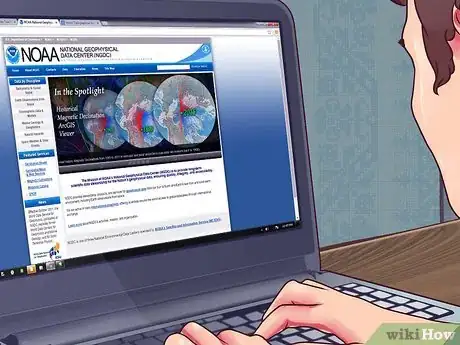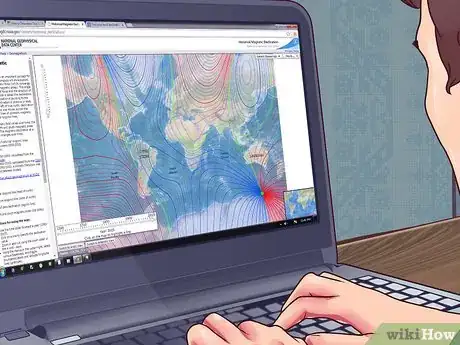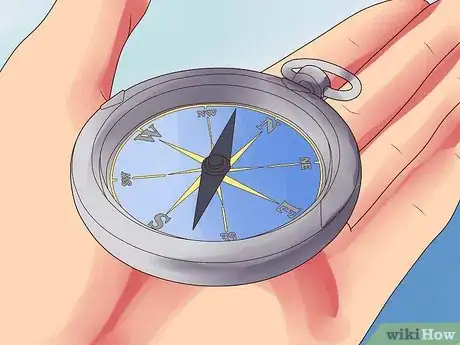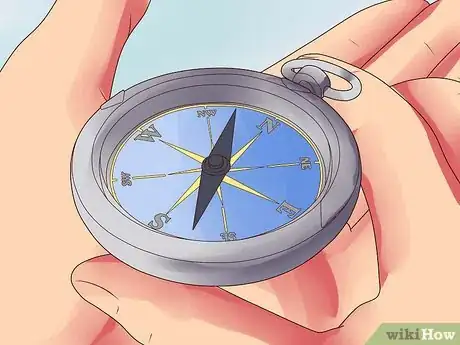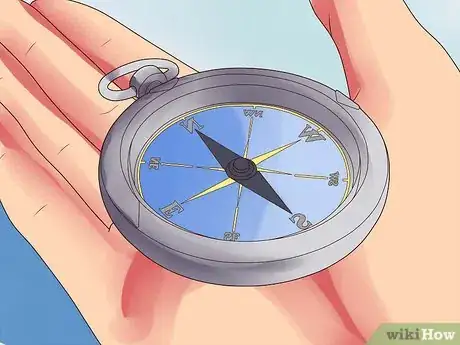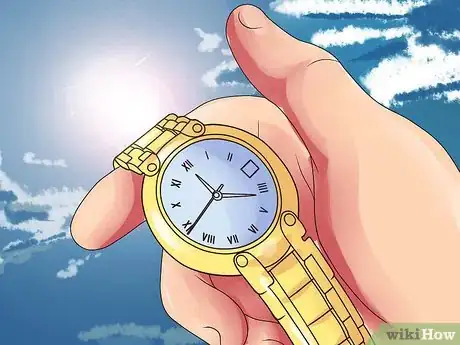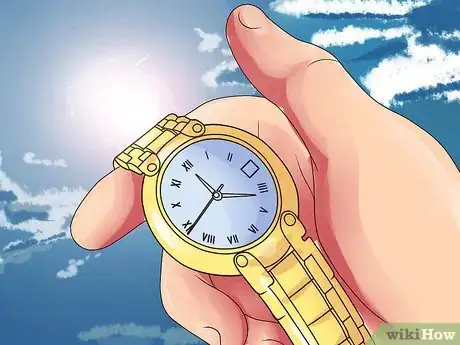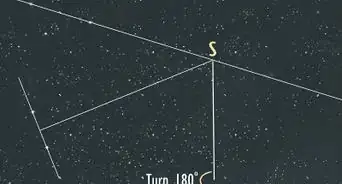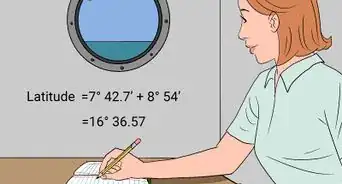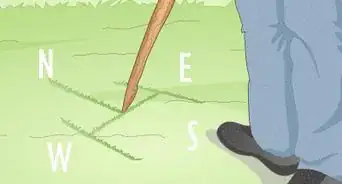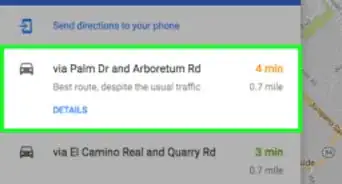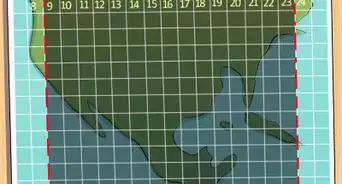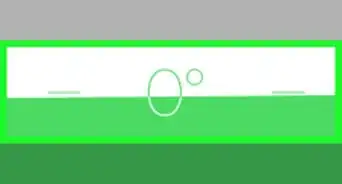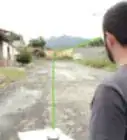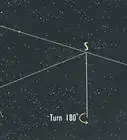wikiHow is a “wiki,” similar to Wikipedia, which means that many of our articles are co-written by multiple authors. To create this article, 9 people, some anonymous, worked to edit and improve it over time.
This article has been viewed 65,822 times.
Learn more...
Did you know that most compasses don't actually point to the North Pole? It's true! In fact, most compasses point in the direction of magnetic north, a spot in the Arctic that is near to (but not the same as) the North Pole. In casual, everyday situations, this minor difference is often ignored, but if you're seriously attempting to navigate in the wilderness, it can present problems. Fortunately, there are a variety of ways to find true north (the direction that points toward the North Pole) using everything from a modern computer to nothing more than the sun, moon, and stars.
Steps
Adjusting a Compass for Declination
-
1Find your local declination from the NGDC. One of the things that can make the difference between true north and magnetic north so difficult for navigators is that the effect on compasses can change over time. This phenomenon is called declination — as the earth's magnetic field fluctuates, the number of degrees by which a compass will be "off" from true north will shift accordingly. Thus, to accurately adjust your compass to account for this effect, you'll need a recent declination value for your location.
- Luckily, the National Geophysical Data Center (NGDC) keeps up-to date records of global declination values. At the NGDC website, you can enter your current location to receive the most recent declination value available for your area.[1]
-
2Alternatively, find your declination from a map. Some physical maps will also include declination values for the area displayed in the map. Topographical maps are the most likely to include this information, though it can be in other types of maps as well. If you're considering navigating by map and compass, consider checking your map's legend to see whether the map contains accurate declination data.
- Note, of course, that declination changes over time, so old maps can quickly become out of date.[2] For the most accurate values, use the most recently-published map available.
Advertisement -
3Find magnetic north with your compass. Once you know how "off" your compass is from true north, it's not hard to adjust for this discrepancy. Begin by finding magnetic north. Hold your compass flat and level in front of you. If your compass has a travel arrow (usually a skinny red arrow on the flat lower portion of the compass, point this forward. Watch the motion of the compass needle. When the needle stops moving, note the direction the needle points. This will be the north-south axis.
- Most modern compasses have a needle that is half red and half white. In this case, the red end of the needle is the north-pointing end.
-
4Turn the orienting arrow so it points ahead of you. If you're navigating by compass, typically, at this point, you would adjust the compass's bezel to that the direction you're intending to travel is directly in front of you, aligned with the travel arrow. In this case, since we want to find north, we'll turn the bezel so that the "N" (and the wide arrow beneath it) is directly in front of us.
- Note that this magnetic north, not true north — we still need to adjust for declination.
-
5Adjust for declination. Turn your body until the compass's needle is lined up with the orienting arrow on the bezel (and, thus, the travel arrow as well). You are now facing toward magnetic north. To find true north, turn the bezel the same magnitude and direction as your declination value. Most compasses will have degree markers on the bezel to help you do this. Next, line up your needle and your orienting arrow by turning your body again. You should now be facing true north!
- For example, let's say that we originally obtained a declination value of 14o E for the area we're in. If we're facing towards magnetic north, we would turn our bezel 14o to the east (clockwise, in this case). Then, we would turn to the left (which is west) to line up the needle with the orienting arrow, leaving us facing at true north (14o west of magnetic north).
Finding True North Without a Compass
In the Northern Hemisphere
-
1Use the motion of the sun. If you don't have a compass, don't worry — it's still possible to find true north by using natural clues. For instance, because the sun rises in the East and sets in the west, it's possible to use this information to get a rough sense for the direction of north. Just after sunrise, keep the sun on your right to face north — just before sunset, keep the sun on your left. At noon, the sun will be directly south, so face away from it to find north.[3]
- One way to get a "north" reading that's a little more accurate is to use a stick as a sort of sundial. Plant a stick or pole that's a few feet high in the ground and mark the tip of its shadow on the ground. Wait about 15 minutes, then mark its new location. Stand with your left foot on the first mark and your right foot on the second. You will be facing more or less towards true north regardless of the declination where you are.
-
2Use an analog watch. One handy trick for finding true north involves using the hands of a non-digital watch. To start, remove your watch and hold it in your hand with the hour hand facing forward. Turn your body so that the hour hand points toward the sun. Find the midway point between your hour hand and the 12 o'clock mark at the top of the watch. This will point along the north-south axis.
- For instance, let's say it's 4:00 PM. The midpoint between 4:00 and 12:00 is 2:00, so if we point the hour hand toward the sun, the north-south axis will be a little less than a quarter turn to our left. Since it's in the afternoon and the sun is setting in the west, we can infer that north will be behind us if we face toward the 2:00 marker.
- Don't forget to compensate for Daylight Savings Time! If your watch is adjusted for DST, use the 1:00 marking rather than the 12:00 marking and proceed as normal.
-
3Look for clues in Nature. Certain natural organisms (especially plants and trees) can give clues about which direction is north. To be clear, however, these rules are very "loose" and will not always work, so most of the time, other methods are preferable. Before are a few examples of what to look for:
- Moss: May be thicker on the south sides of trees due to more sunlight.
- Trees: Bark may be duller-colored and branches may stretch higher toward the sky on the north side due to less sunlight.
- Ants: Ant hills may tend to be on the southern side of natural features where the sun is warmer.
- Snow: Snow may melt faster on the southern side of trees and rocks where it receives more sunlight.
-
4Use Polaris, the North star. It's surprisingly easy to find north at night if you know what you're looking for. Polaris (also called the North Star) is almost perfectly aligned with the earth's North Pole, so if you can find it, you'll know exactly where true north is. There are several ways to find Polaris, but the easiest way is usually to use the Big Dipper — the two stars at the end of the "spoon" portion of the constellation point directly to Polaris.
- Unfortunately, Polaris can’t be seen from the Southern hemisphere, so it's only useful for navigation north of the equator.[4]
-
5Use the moon. Like the sun, the moon moves across the sky in an east-west direction. This means that you can use the position of the moon to help orient yourself toward true north at night. Early in the night, keep the moon on your right to face north; late in the night, keep it on your left. When the moon is at its highest point in the sky, it's roughly due south, so face away from it to find north.[5]
- If the moon is a crescent, you can also mentally draw a line through the horns of its crescent to the horizon to find south, then face away from this to find north. This works best when the moon is high in the sky.
In the Southern Hemisphere
-
1Use the motion of the sun. Because the light from the sun, moon, and stars hit the Southern Hemisphere at a different angle than they hit the Northern Hemisphere, the process of finding north is a little different south of the equator. For instance, while the sun still rises in the east and sets in the west in the Southern Hemisphere, at noon, it is due north, rather than due south.
- This means that, while you'll still want to keep the sun on your right just after sunrise and on your left just after sunset to face north, you'll want to face towards it to find north at noon.
-
2Use an analog watch. Because the sun sweeps out a northern arc (rather than a southern one) in the Southern Hemisphere, the directions for finding north with a watch are essentially reversed. Point the 12:00 mark on your watch toward the sun, then find the line that marks the halfway point between the 12:00 mark and your hour hand. This represents the north-south axis.
- For instance, if it's 6:00 PM, we would get a north-south axis running through the 3:00 and 9:00 markings on our watch. Since it's the evening, we know that the sun is in the western half of the sky. Thus, when we point the 12:00 marking at the sun, the 3:00 will point roughly towards true north.
-
3Use the Southern Cross at night. The Southern Hemisphere doesn't have a convenient pole star like Polaris to make navigation easy. The closest equivalent is a constellation called the Southern Cross that rotates tightly around the south celestial pole. To estimate due south, find the Southern Cross and draw a line directly down to the horizon. This will be approximately due south, so face away from this to find due north.[6]
- The easiest way to find the Southern Cross is to use the Pointers — two bright stars in the southern sky that point directly at it. The Pointers can be found in the white, splotchy streak that is the Milky Way, which is often visible in locations with little or no light pollution.
-
4Use the moon. In the Southern Hemisphere, the moon still travels from east to west, just like the sun. However, at its highest point in the sky, it faces due north, not due south. This means that the directions for navigating with a crescent moon are reversed — the line extending through the horns of the crescent to the horizon will point roughly to the north, rather than to the south.
Community Q&A
-
QuestionHow do I calculate magnetic declination?
 Andrew GeepCommunity AnswerFirst, find true north. The most accurate way is by finding the North Star. Make a mark on the ground that is not apt to be disturbed by walking over it. Make another mark indicating north. Or, in the daytime, use a shadow stick method that has equal shadow lengths. In the daytime, while keeping the red compass needle pointing to the “N,” point your compass direction of travel arrow at the true north mark set up before. Read the difference on the direction ring of the compass.
Andrew GeepCommunity AnswerFirst, find true north. The most accurate way is by finding the North Star. Make a mark on the ground that is not apt to be disturbed by walking over it. Make another mark indicating north. Or, in the daytime, use a shadow stick method that has equal shadow lengths. In the daytime, while keeping the red compass needle pointing to the “N,” point your compass direction of travel arrow at the true north mark set up before. Read the difference on the direction ring of the compass.
References
- ↑ http://www.ngdc.noaa.gov/geomag-web/#declination
- ↑ http://www.rei.com/learn/expert-advice/compass-declination.html
- ↑ http://www.sunearthtools.com/dp/tools/pos_sun.php
- ↑ http://earthsky.org/brightest-stars/polaris-the-present-day-north-star
- ↑ http://www.naturalnavigator.com/find-your-way-using/moon
- ↑ http://www.teara.govt.nz/en/southern-cross/page-2
